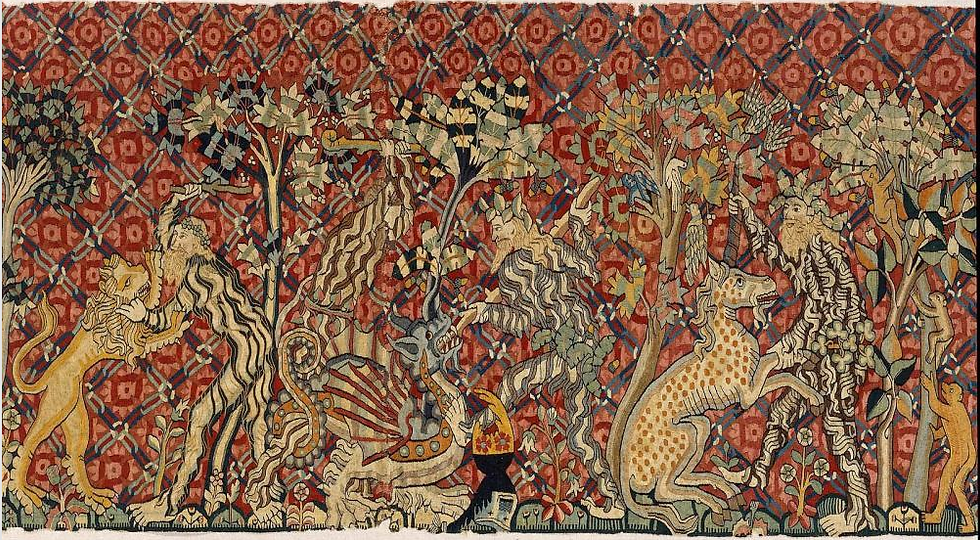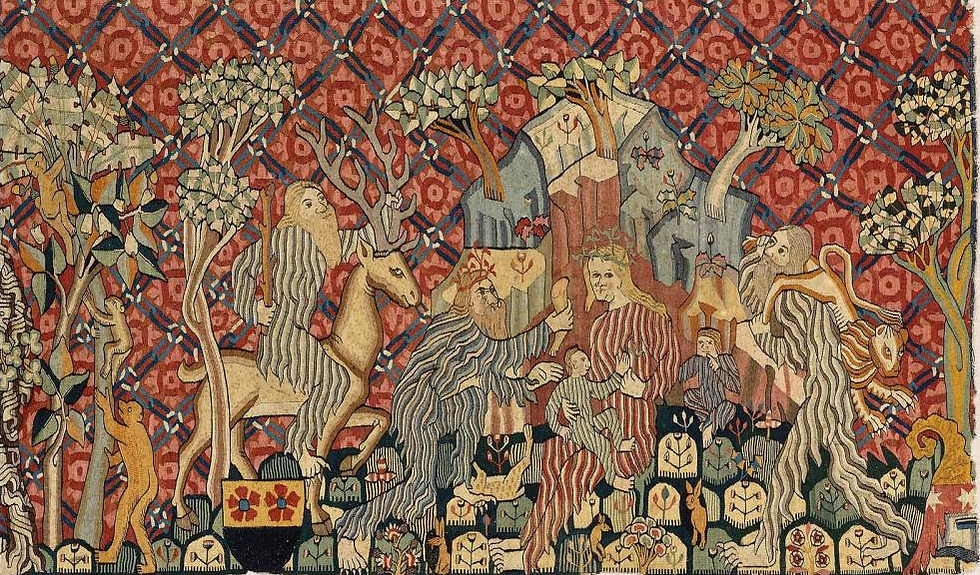This remarkable medieval tapestry depicts a battle between giant wild men, clothed only in materials from the forest and their own hair, and the defenders of a castle.

This glorious medieval tapestry of Wartburg Castle of WildMen and Moors, is German (probably Strasbourg, Alsace) from about 1440. Fusing both Pagan and Christian metaphors it depicts a series of scenes of (left to right), wild men attacking Moors in a castle, wild men fighting with lion, dragon, and unicorn, and wild men carrying food to a wild woman with two children seated on a hill or mountain with stylised trees, plants and animals.
The red background is covered with roses in two shades of pinkish-red, framed by diamond lattice formed by links of chain in blue, darker blue, and white. In lower part of tapestry, on the right half, a shield divided horizontally, upper half yellow with two red roses with blue contours. The lower half is black (Blümel, Alsace). The same arms appear as manteling on a helmet lower centre of tapestry.
Below you can see the wild giants with their unkempt hair and beards attack with sticks and stones. Looking like tree spirits some of them are girdled with leaves and branches twined around their waist.

The black inhabitants of the fortified castle fight with bows and arrows. The men’s neatly groomed beards, robes, and headbands identify them as Saracens or perhaps as Black converts to Christianity. Their king, queen, and princess watch from the keep, while heralds at the top of the castle call out for assistance. Woven within this story is also the story of two families.
Two family crests appear in the design. One of these families, the Zorns, had a member who had fought and died in the Crusades. They later included a moor in their coat of arms, so perhaps this explains the inclusion of the Black defenders in the tapestry.
The tapestry is unusual, and perhaps unique then, in depicting what would have been seen as marginalised groups in Christian Europe at the time in the form of the Moors (castle defenders) and Pagans (wild men).
Another notable instance is the contrast in skin colour and the reversal of our expectations that white should denote 'civilization' and black (historically speaking) the lack thereof. Curiously while the Wild Mens faces have clearly defined features the Moors remain indistinct as you can see below. Even accounting for being smaller in size, their faces do not have the same expressive quality. The eyes which are so visible on the wild men are not a prime feature on the Moors. Not even on the ones in close contact with the wild men as seen above.

What we see here are that the men with their bows and arrows are used to fighting from a distance. The wild men on the other hand with their sticks and stones are used to hand to hand combat. For the archers coming into close contact with the wild men outside the castle walls it is an ill matched battle The wild men see death up close and personal. This is further emphasised by their hunting prowess in later scenes. It is perhaps because of this that they seem so much closer to life. Nature is teeming around them with an abundance of trees, flowers, and animals. Finally, what greater symbol of fecundity is there than the image of the mother and with her two children?
Under the castle you can see the top of a helmet that looks rather like a sandy coloured wizards hat with a curly top. It is described as an ibex horn with red band and two white stars (representing Zorn and Strassburg).
In the next section of the tapestry a stag to the right of the castle watches the wildmen battle with a lion, a dragon, and a unicorn. These are heraldic symbols representing authority and power. The highly decorated dragon looks particularly splendid with its patterned tail and opening wings.
Interestingly the wild man is stood in the same pose classic as St George and St Micheal, both dragon slayers with a wooden stake or spear entering the dragons' mouth. A scene often seen in churches, this image is further reinforced by the wild man placing his foot on the dragon as is so often the case with the saints standing on their respective dragons.

They then present gifts of wild game to a mother and two children up on a hill sat at the entrance to a cave. The child on the mothers lap is reaching up towards her breast. This too is resonant with Christian symbolism, the pose mirroring that of the Virgin and Child.
We should not underestimate these wild men. They are certainly wild, one of the gift-givers has prominent fangs. They have large hands and even larger feet. Their feet have large claws. These are the feet more of a bear than a man. A hint then of something bestial. An untamed animal wildness. Yet despite this wildness one kneels down before the mother and child.
Who, or what are these beings?

If we are in any doubt as to their ferocity and bravery a wild man to the far right above has a lion slung over his shoulder. In all probability the heraldic lion from the earlier scene.

This curious and challenging tapestry upends our notions on what is civilised and what is wild. It is a curious piece, for at this time the lion was not only seen as powerful in heraldic devices but also as a Christian symbol. Yet here we see it upended and slung over the shoulder of a deeply pagan image. Again Bear as an original pagan god comes into play. He who was usurped by the lion as medieval bestiaries put the lion at the top of the Christian world view or the animal world.
In reading the tapestry from right to left what we see is a hoard of wild men attacking the castle, then the status quo is upended as symbolised by the defeat of the heraldic beasts the lion, dragon and unicorn.
Then we see a wild man riding a stag, (possibly the same one who was earlier watching the wild men defeat the beasts) stick in one hand and holding one of the antlers in the other riding towards the mountain. He is the master of the wild.
The story concludes with a scene of fertile abundance with trees, flowers and many animals. These fearsome wild men who have done battle with a great castle, fought fearsome beasts, tamed wild animals and now show obeisance to another. They bring their offerings and kneel down, for there sits the wild mother upon the flowering mountain.
On a further note there is something else that strikes me about this scene and that is its resemblance to the Wilde Mändle dance of Oberstdorf in the Allgäu south German. (See my post about it here)

It is said to be the oldest ritual of its kind in Germany. This dance begins with complex agile movements and then choreography with sticks, at one point they build a pyramid reminiscent of the mountains before ending with a homage to the mead in their wooden mugs. The tapestry images too bear marked resemblance to the wild men of Oberstdorf.
Perhaps the wild woman is mother nature herself in the heart of the mountain. Maybe her breast is symbolic of the mountain springs bringing waters down into the valleys. The living waters of the earth that bring life. Maybe the mead and the dancers song to it is symbolic homage to this.
This beautiful and unusual tapestry seems to be weaving in (forgive the pun) Christian symbolism with a much earlier story involving a mythos of the Wild Men well known across the region at the time. The images from this mythos are being used to convey or are transformed by Christian symbolism in order to convey a message to the medieval viewer. To ensure complete understanding the heraldic devices of the two families are also included.
It is a very, very, interesting meeting and melding of stories and images. I would suggest too that it gives us insight into imagery we see in churches with the pagan reinterpreted to Christian symbolism. Thus providing evidence that far from being original Christian symbols images (as some argue) such as the green man and the wild man, they are indeed much more ancient tales retold for a new audience. This is of course why I love wandering around churches. Because whatever your belief system they are wonderful repositories full of history and culture.
The tapestry and the ancient dance still retain their magic and mystery. There is a very great deal more to be said on this subject and I shall certainly return to it at some point.
I hope you have enjoyed looking at this fabulous tapestry and reading some of the stories woven so beautifully into it.
Amanda x
My Jack In The Green shop donates to Ancient and Sacred Trees social enterprise planting and protecting trees and rewilding so it is a win, win for you and for trees! I have a great Green Man collection and other folklore items. Or, if you've enjoyed this post and would like to see more buy me a drink :-)
Tapestry Images from the Museum of Fine Art Boston https://collections.mfa.org/objects/106003


Comentários